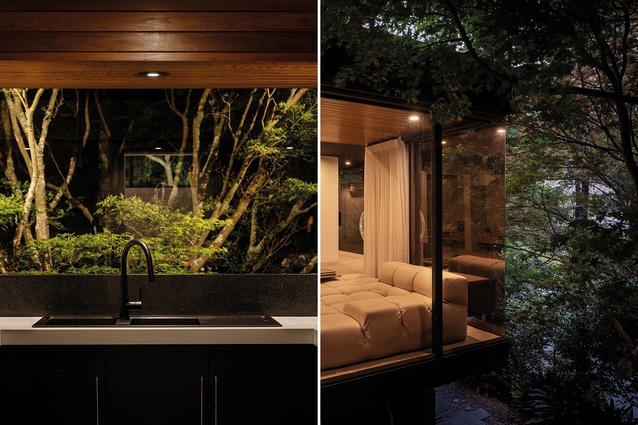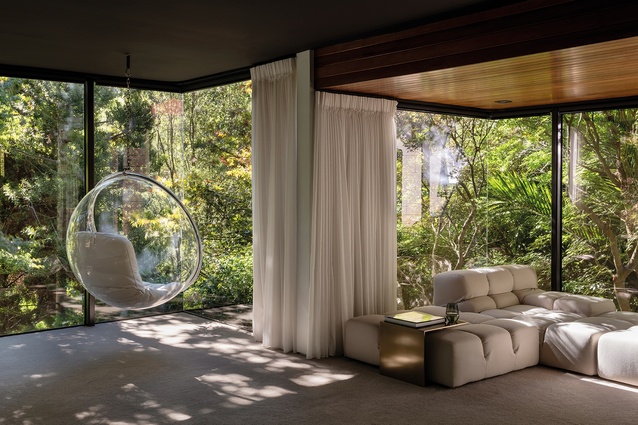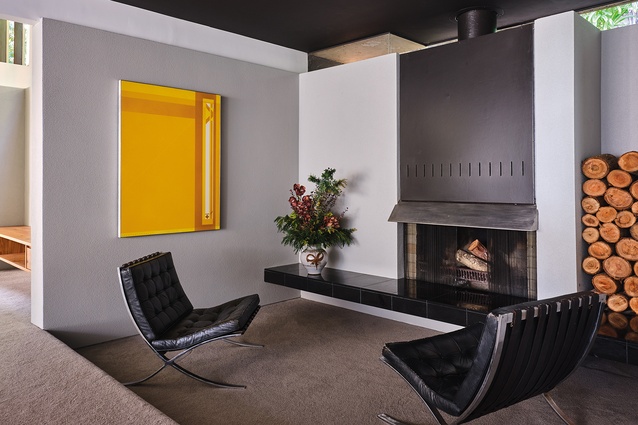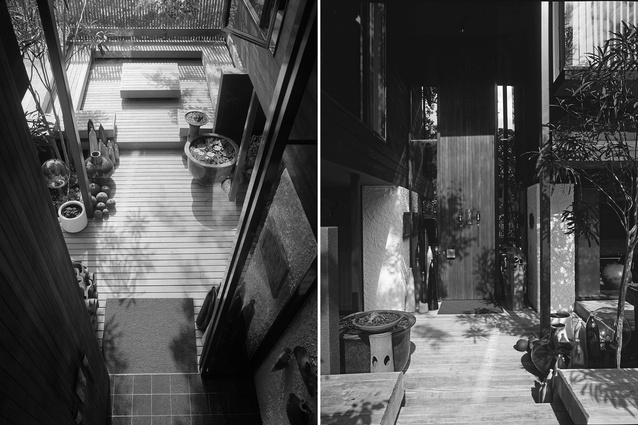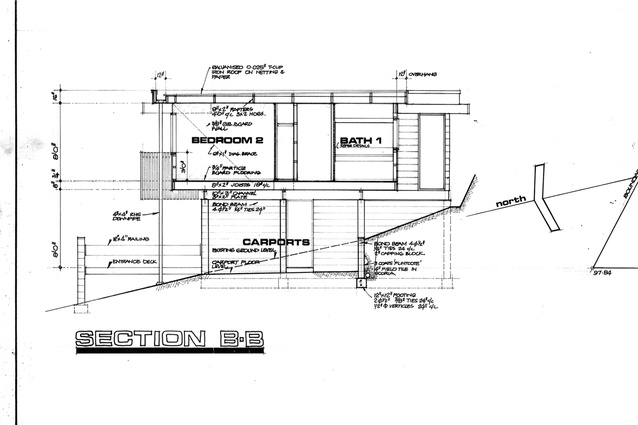The Sang House: Retracing an icon
As beloved late Kiwi architect Ron Sang's own Remuera house prepares to go to auction, Maggie Hubert looks back at the home's architectural evolution from 1973 to now.
An architect who designs their own house has an opportunity to present their purest ambition without compromise. They will often ignore constraints applied by market appeal or a desire to conform with the fashionable, instead relishing in the prospect of experimental forms and refined finishes and details.
The Sang House (1973), designed by the late Ron Sang (1938-2021), is settled and established comfortably on its site, somewhat hidden behind luscious greenery. The architecture and its relationship to nature play reinforcing roles.
There is a sense of a smoky, floating glass box sitting back from the street, both discreet in its mysterious reflective materiality and bold in form – it has the ability to both stand out and disappear.
An alluring and evocative cherry red trim delineates the structure. Immediately, the level of detail to be found throughout the house is indicated by the graphic “58” punched into a horizontal concrete mass, an echo of the architect’s hand stencilling the numbers on paper for translation on-site and a statement of the beautifully orchestrated modernism that awaits.

“We had sold our two-bedroom apartment on Owens Road unexpectedly when a buyer made us ‘an offer we could not refuse.’”1This good fortune allowed Sang to purchase a challenging triangular site in Remuera. The wide frontage was perfect for a long one-room-deep house with a north/west outlook. The government at the time wanted to slow the building economy by capping the maximum house size at 1000 square feet (92.2 metres squared). Sang knew this was inadequate, so the house was designed to be extended in all directions in the future.”2
Large sculptural expressions are pushed further by their materiality. Textured and thickly layered plastered concrete block contrasts dramatically with refined, sleek glass expressions. Cedar weatherboard cladding adds softness and warmth.
In 1985 Sang realised his plans for extending the house. The steep driveway up to the former garage (now downstairs living area) was removed, and replaced it with the ground level garage and pool atop.3
Subdued and low-sitting cedar-lined garage doors flanked by elegant mirrored glass corners serve to visually lighten the structure above, a cantilevered concrete planter box spanning the length of the double garage.
The gardens surrounding the house were carefully curated by Sang and Ted Smythe4 to create a zen landscape5 and one that functioned with the house, allowing winter sun in when the leaves thin out and softening the summer sun as the bush thickens. Autumnal colours are stunning against the smoky mirrored glass and work in harmony with the exterior colour palette and trim.
The transition from the street is a calming journey, slow and immersive, along a meandering inlaid brick path framed by ginkgos, kauri, and Japanese maples. It is a process of discovery with glimpses to both soft and evocative landscaping and strong architectural movements along the way.
With the 1980s extension, a cantilevered balcony was closed in with full-height glass and the living, kitchen, and dining rooms were extended by two metres to the front. “This totally changed the interior outlook as the trees matured, giving the house a wonderful feeling of being in a forest. A swimming pool was built on top of the garage.”6
There is a powerful sense of arriving under a cantilevered glass box. The rise to the entrance culminates at the outdoor courtyard. A dazzling in situ pool bounces light gently around and invokes a place of entertainment and social connection in the Western afternoon and setting sun.

A 5.5-metre-high cedar door was installed at the entranceway. It has remained perfectly straight in the last forty-three years. “This big door has now become one of my signature features, so much so that many of my clients demand a ‘Sang Door’ in their brief.”7
The double-height entrance door is a delight at the house’s threshold and became a characteristic gesture of Ron Sang’s work. Sang practised Feng Shui in his design. He said, “one of the reasons you have big doors is when you open them, they let the energy in.”8 Touchpoints like handmade Guy Ngan9 door handles are elegant and understated elements, indicating detail and attention to craft found throughout a house where natural and artificial light was carefully composed to display Sang’s extensive modern art collection.10
Designed one-room-deep and elongated, there is a straight east to west visual connection to nature. The plan follows a public to private gradient, where the double-height entry volume spatially separates public from private. Great social gatherings can take place with a clear separation from the private sleeping spaces.
Past the impressive hinged door is a large open space. There is a study to the left and bright lower level living to the right that flows back to the pool. Immediately ahead, the inviting floating staircase leads up to a bridge suspended in this dramatic void. A triangular double-height clerestory volume pulls in natural light and connects the outdoors from the front of the house straight through to the bush behind. The parallels between The Sang House and The Brake House,11 designed three years later, are evident in gestural moves and devices such as this.

Sang plays with spatial compression and release throughout the house, the experience of moving through a narrow or low-ceiling area to a lighter, open volume, where the sense of space is experientially heightened by contrast. The choreographed sequence of scale produces a delightful effect and is further emphasised by the dark treatment of the ceiling colour. It also serves to encourage movement towards the lighter spaces, channelling the view to the full-height glass living room.
One suddenly feels they are standing in the landscape within the treetops. There is a grand sense of floating above the street from this vantage point, visually connected to the neighbourhood, the trees, and the valley hill.
The sunken den off of the dining room is a place to gather around the fire. It suggests intimacy. Slight clerestory glazing adds a level of sophistication and connection to the bush behind.
Sang’s strategic 1985 additions transformed the small 1970s timber house into a spacious treehouse, sophisticated and timeless.
The kitchen is a perfectly formed separate room within the glass box, creating playful circulation all around. It serves as a great spatial organiser, creating a separation of space without a feeling of enclosure. There is a wrap-around bench and a skylight above. A service opening in the kitchen offers practicality and prevents a break in connection to the Western trees and sun. While preparing meals, one can imagine total immersion in the treetops.
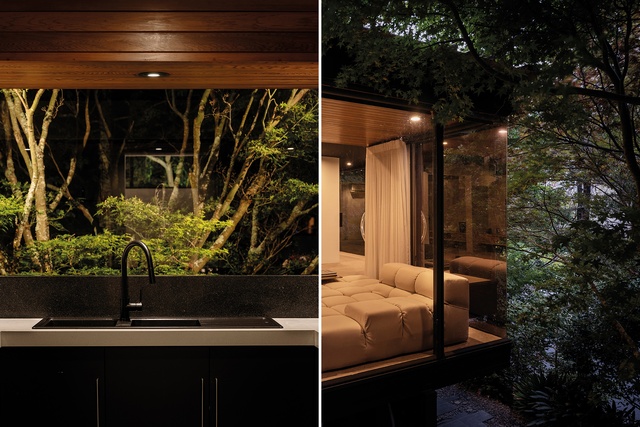
Architect Ken Crosson has visited the Sang House throughout its evolution:
“There’s an interesting style about the 1970s and big change in the 1980s. With [Sang’s] extension of the front, it went from a textured wooden house to a modernist glass house, and in a way, disconnected it physically while maintaining visual connection. In the living area, it freed up space and allowed for looser living. The extension was symbolic of where his architecture was going, very much like the tatami room at The Brake House.”12
The main living space is elegant and comfortable, with a hanging bubble chair by Eero Aarnio in the mitred glass corner, reminiscent of the futuristic ambition of the house’s conception. Off to the side a smaller glass box is expressed with a low timber-lined ceiling; it is snug and intimate. Surrounded by bush on all sides with no connection back to the street, this moment is truly private.
Ron Sang’s Feng Shui principles heavily emphasised the equal importance of the architecture and its sympathetic placement of the home within the landscaped garden.
“Study nature, love nature, stay close to nature. It will never fail you.” —Frank Lloyd Wright13
Born to Chinese immigrants in Suva, Fiji in 1938, Sang was the second youngest of nine children. As a boy, he recalled the experience of sleeping under the sloping iron roof above his parents’ shop and creating a boxed space within, just big enough for one, in search of pseudo-privacy. The mind of the architect began to hum.14 He moved to Tāmaki Makaurau in 1957, where he studied architecture at the University of Auckland. In 2001, his 1976 design of The Brake House in Titirangi won an NZIA Enduring Award.15
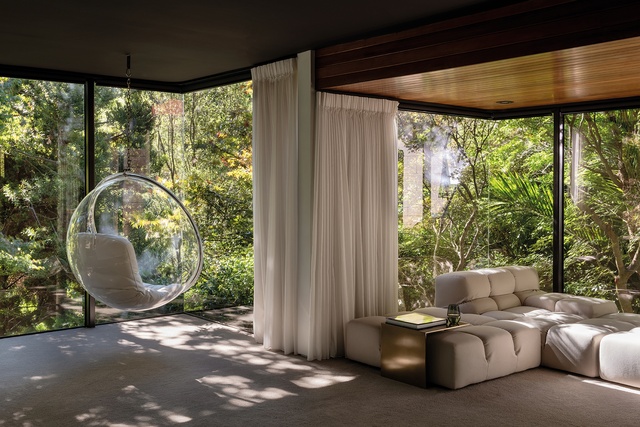
He was unquestionably, and uniquely amongst his contemporaries, a modernist, hugely influenced by the clean lines of Mies van der Rohe, Le Corbusier, Marcel Breuer and especially Harry Seidler. An Austro-Australian émigré architect, Seidler was a hero and source of inspiration to Sang. Sang struck up a relationship with Seidler.
“I still recall visiting The Seidler House in Killara, Sydney, in the 1970s. I spent several hours wandering through this magnificent concrete house with its timber ceilings and dark grey granite floors.”16 Sang was influenced by Seidler in his use of reinforced concrete, crisp geometry and cantilevers in The Sargent House and The Sang House in Remuera, and design elements like the treatment of gutters in The Brake House in Titirangi.17
Architect and former business partner Simon Carnachan said this about Sang’s guiding principles: “The craft of putting buildings together with precision, style and design, and the necessary personal and persuasive attributes in client interaction was well taught, together with a belief that business and art can be successfully combined and coexist. That education expanded into a demonstration and philosophical position of how to live the fullest and most creative life, how it should be conducted and how the sense and opportunities available should be harnessed and enjoyed. The notion that creative architecture required that one lived a full experiential existence, a prerequisite for shaping environments for others, was thoroughly demonstrated.”18
Sang lived a fully experiential existence. A devoted collector of art, pottery and rare chairs, Sang also published art books. He practised as an architect for over fifty years and was made an officer of the New Zealand Order of Merit for services to architecture and art in 2000. His generosity of spirit towards his friends and family in life was vast.

In the architecture community, Hapua Street in Remuera is one of the most significant streets in New Zealand. “I’ve often thought you’d be hard-pressed to find another road in Auckland with as many architect-designed houses,” says London-based New Zealand architect and architectural historian, Giles Reid.19 The bottom part of the street was originally laid out with state houses in their most quintessential era. In the early 1960s, with an exciting shift in character, the road was extended, carved into the valley beyond.
In the rich and leafy valley, proximate to the city, a new utopian experiment unfolded. Works by esteemed contemporaries of Ron Sang surround The Sang House at 58 Hapua Street. Claude Megson’s Rees Townhouses (54 Hapua Street), built in 1974, were considered by the prolific architect to be his best work. They were commissioned by Gavin Rees, owner of a pioneering interior design shop importing modernist furniture. The Mrkusich Townhouses (64 Hapua Street), built in 1968, were commissioned by artist Milan Mrkusich and wife Florence, and set into the hill just below their own house, designed by Mrkusich in 1951-52.20
Bill Wilson of the iconic mid-century practice Group Architects and tutor to Ron Sang at the University of Auckland built at 73 Hapua Street. Number 74 was designed by Geoff Newmann and renovated by architect Lisa Webb in 2014. Lilian Chrystall, one of New Zealand’s pioneering female architects and first female lecturer at the University of Auckland School of Architecture, designed the house at 76 Hapua Street.21 In more recent years, 78 Hapua Street was designed by Richard George, a double-storey pure glass box designed for the architect to live in himself.22 In 2021, an NZIA award-winning house by Richard Naish of RTA Studio was completed, a statement of strong gable forms and a nod to the historical state housing on site.
There is a shared sense of custodianship in the neighbourhood amongst the owners of these homes, and a drive to preserve the beauty of the street in its time capsule. Mrkusich Townhouse owner Teresa Janssen sums it up well, saying, “The interesting mix of housing including so many important works of architecture have created a fascinating streetscape. The landscape of the valley and cul de sac creates a place where neighbours naturally interact and there are street parties and an active pest control group bringing amazing bird life to the area. It is such an interesting place.”23
The Sang House, 58 Hapua Street, will be sold by auction by Webb’s in collaboration with Wall Real Estate. The auction will take place at Webb’s Gallery, 33a Normanby Road, Mount Eden (unless sold prior) on Sunday 25 July at 2:00pm. It is open for viewing on Sunday 18 July from 1:00-2:00pm. Find out more at webbs.co.nz.
This essay was originally written for Webb’s and republished with permission.
1 Sang, Ron Sang Architect (Auckland: Ron Sang Publications, 2017), 263.
2 Sang, 263.
3 Sang, 263.
4 Ted Smyth (1937-2019) is regarded as one of the finest garden designers globally and widely acknowledged as a primary innovator in the development of modernist garden space. He is an Honorary Fellow of the New Zealand Institute of Landscape Architects.
5 Janey Knight, and Anna Woodroffe. 1998. “A Collector’s Item,” New Zealand Home & Building, February/March 1998, 121.
6 Sang, Ron Sang Architect, 263.
7 Sang, 263.
8 Stuff, “Ron Sang’s life amid art.”
9 Guy Ngan (b. 1926) was a New Zealand-born Chinese artist with a strong national and international presence who worked across various mediums.
10 Bonny, Stephanie, and Marilyn Reynolds, Living with 50 Architects: A New Zealand Perspective. (Auckland: Cassell Limited, 1980), 104.
11 The Brake House was designed and built for Brian Brake, a renowned photojournalist, in the hills of Titirangi in 1976. It is included in the Phaidon 20th Century World Architecture Book, which showcases the most outstanding works of architecture from around the world. The house has a Category 1 heritage listing, is recognised amongst the country’s top 20 modern buildings and, in 2001, was awarded the New Zealand Institute of Architect’s inaugural Enduring Architectural Award.
12 Ken Crosson, personal communication, 4 July, 2021.
13 Carla Lind, The Wright Style: Re-Creating the Spirit of Frank Lloyd Wright (New York: Simon & Schuster), 3.
14 Justine Chin, interview with Ron Sang, Auckland, October 20, 2020, audio recording.
15 Architecture Now, “Vale Ron Sang.” Accessed 3 July, 2021.
16 Sang, Ron Sang Architect, 331.
17 Chin, Interview.
18 Sang, Ron Sang Architect, 17.
19 Personal communication, July 1, 2021.
20 Reid, “This dramatically angled house was designed to display the owner’s art.”
21 Hawkes, Colleen. “Mid-Century gem by pioneering female architect Lilian Chrystall up for sale.” Accessed 3 July 2021. stuff.co.nz/life-style/home-property/90201989/
22 Reid, personal communication.
23 Teresa Janssen, personal communication, 3 July, 2021.



